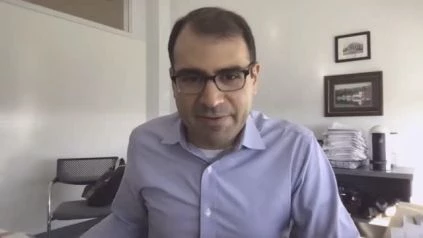Alfred L. Garfall, MD, MS – Assistant Professor of Medicine, Perelman School of Medicine discusses ASH 2020 abstract – 180 Updated Phase 1 Results of Teclistamab, a B-Cell Maturation Antigen (BCMA) x CD3 Bispecific Antibody, in Relapsed and/or Refractory Multiple Myeloma (RRMM).
Context:
MM eventually relapses and becomes refractory to therapy, indicating unmet needs in a patient (pt) population. Teclistamab (JNJ-64007957) is a BCMA x CD3 bispecific antibody which induces cytotoxicity mediated by T cells against BCMA-expressing MM cells. Results from the ongoing review of teclistamab in RRMM (NCT03145181) previously mentioned included a 67 percent objective response rate [ORR] for the intravenous 270 μg/kg dose (iv) (Usmani et al, ASCO 2020 Oral Presentation #100). Updated findings and newly usable data for subcutaneous (sc) administration are provided here.
Methods: Pts of MM for proven treatments, which is RR. The main objective is to evaluate the recommended dose(s) for phase 2 (RP2D). Multiple doses of sc and iv ± step-up were tested. Adverse events (AEs) per CTCAE v4.03 and per Lee et al 2014, cytokine release syndrome (CRS) was graded. Investigator-assessed response using IMWG criteria; bone marrow minimal residual disease (MRD) was evaluated by next-generation sequencing.
Outcomes:
As of 20 Jul 2020, 84 and 44 pts, respectively, earned iv teclistamab (0.3–720 μg/kg) and sc teclistamab (80–3000 μg/kg). Overall, the median age was 64 years (24-82), the median number of previous therapy lines (LOT) was 6 (2-14), 95 percent/79 percent triple-class exposed/refractory, 70 percent/38 percent exposed/refractory penta-drug, and 91 percent refractory to last LOT. Anemia (55 percent), neutropenia (55 percent), thrombocytopenia (41 percent), and leukopenia (26 percent), as well as non-hematologic incidents of CRS (53 percent), pyrexia (28 percent), diarrhea (24 percent), cough (23 percent), fatigue (23 percent), nausea (22 percent), back pain (20 percent), and headache, were included in AEs in >20 percent of pts (both iv and sc combined) (20 percent ). 39 percent of pts had treatment-related grade 3 AEs; the most common were neutropenia (23 percent) and anemia (9 percent). CRS occurred later (relative to the most recent dose) with sc administration in 55 percent and 50 percent of pts with iv and sc dosing, respectively (median time to onset of 1.0-day iv and 2.0 days sc). All CRS events were Gr 1 (n=51) or 2 (n=17) and were usually limited to initial doses. 5% of pts (all iv) had neurotoxicity (2% gr ⇠3), and 12% had an infusion/injection-related treatment-related reaction (including 4 infusion reactions [all iv, 5%] and 11 injection-related reactions [all sc, 25%], all gr 1/2). In 15 percent of pts, Gr 3 or higher infection-related AEs were registered in (3 percent treatment-related). Four 5 gr AEs have been identified (all iv and considered unrelated to treatment by investigator except for 1 case of pneumonia).
The pharmacokinetic findings showed that teclistamab’s half-life assisted weekly dosing of iv. Exposure increased in a dose-proportional manner roughly following weekly dosing of iv or sc medication. The dose of 1500 μg/kg sc had a Cmax equal to that of 270 μg/kg iv and higher than that of 720 μg/kg iv. Following sc dosing, individual time to hit Cmax ranged from day 3 to day 8.
Treatment with teclistamab in both the iv and sc cohorts resulted in pharmacodynamic improvements supporting the mechanism of action, including increases in the activation of T cells and levels of circulating cytokines such as IL-10, IL-2Ra and IL-6.
With the maximum and most active dose levels of 270 μg/kg and 720 μg/kg weekly for iv and 720 μg/kg and 1500 μg/kg weekly for sc, 120 pts were evaluable for response (of note, the response data for 3000 μg/kg sc is not yet mature). ORR was 30/47 (63.8 percent, including n=24 with very good partial response [VGPR] or better, and n=9 with full response [CR] or better), combining these 4 iv and sc dose levels. 1500 μg/kg sc was selected as RP2D, and 6 out of 6 pts are currently in response at this dose (3 PR, 1 VGPR, 2 strict CR) with the incremental deepening of responses over time.
The median time to first response was 1 mo (range, 0.3-4.2) among 48 pts with responses from both iv and sc cohorts, and median response period was not met, with 38 responding pts remaining on therapy for 1.6 to 21.3+ months. For MRD-evaluable pts getting a CR, MRD negative at 10-6 is 4/5 pts handled in the iv cohorts and 2/2 pts in the sc cohorts.
Findings:
Teclistamab has a manageable safety profile that involves low-grade CRS (with no events of gr ⇠3) and low rates of serious infection and neurotoxicity with the administration of both iv and sc. For both, the administration of iv and sc, deep and durable responses were observed. The phase 2 planned monotherapy (at 1500 μg/kg sc) trial and potential combination trials are accompanied by the promoting tolerability and efficacy of teclistamab.

